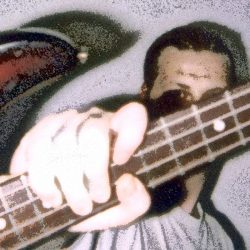A lot of the neck prep for the Ash Stratocaster is identical to the Jaguar – but there are a few differences. For a start – this is an all maple neck – sourced from Northwest Guitars. I want to yellow the maple a little, so that it’s a bit more in harmony with the finish on the body. The Crimson finishing oil on the body hasn’t really darkened the wood too much, and I want to just echo those honey tones, with the neck. I’d quite like to darken the face of the headstock too – quite a few tones darker than the Jaguar – so that it looks a little bit more like an older, vintage neck.
I’ve always been a fan of the larger headstock found on late 60’s and early 70’s Stratocasters. At that time, Fender were looking to use more polyurethane finishes – but found that they had to use nitrocellulose on the headstock, so that they could use the same decal process. Nitro tends to yellow over the years, so darkening the headstock should put it a bit more in-keeping with the period, both in shape and in colour, whilst hopefully harmonising with the tones of the ash body.
The neck came already lightly coated in clear nitro – so after a good clean over with naptha, (lighter fluid to those of us in the UK), and after filling the tuner holes and truss rod recess with paper, as before, a few light coats of clear coat nitro go all over the neck – front and back. This is followed with a few coats of the same Light Tint Amber nitro I’ve used on the Jaguar.
The light tint builds up quite quickly, and once the right tone is achieved, the neck is left to dry overnight. The finish is sprayed over the entire neck – although I’ve gone a little bit light on the block where the neck attaches to the body. The finish is also applied over the frets. These will be cleaned off later.
Next, the neck is loosely masked off and further coats of light tint are shot onto only the face of the headstock, as it lies flat on the bench. Applying coats gradually, and letting things dry in between coats – it takes a day or so to reach the required tone on the headstock face. After letting this dry for a few days, a final few coats of clear are sprayed over the neck to cover and key into the tinted coats, and then it’s all left to dry for a week or so. The clear will give me a bit of meat to polish into – so I don’t sand back through the levels of tint – causing unwanted variations in tone.

After the headstock has dried sufficiently, the decals can be applied using the same process as on the Jaguar. Again, I’m using my “Custom Build” roundel. I’m not in the business of creating deliberate fakes to con people. I just aspire to being able to make a guitar, at least as good as one put together by the good people at Fender. Once the decals have dried, the fingerboard is masked off with paper and some extra clear coats are built up over the face of the headstock alone. It’s all then left for the lacquer to fully cure and shrink back – before the whole face is levelled with 400 grit over a flat sanding block.
When the decal edges have been blended into the finish, I like to shoot a few more coats of clear, and leave to dry well – preferably for a few weeks. The next job will involve fitting the tuners – so I don’t want a soft, easily marked finish – I want to be able to polish it up properly first.
It is adviseable, however, before setting the neck aside to cure, to remove the nitro that has been sprayed over the frets. Fender used to use a specially modified nail with a notch cut in it, and literally scraped the finish off. I prefer to cut the nitro using a sharp scalpel, and then pop the nitro skin off. You need to do this before it’s had too much time to harden and adhere to the frets. If you use a fret shield to help protect the fretboard as you cut along the base of each fret, a sharp scalpel cuts through the, still slightly pliable, lacquer. The neck will eventually be rubbed back to a sleek satin finish, and the fingerboard polished up with progressively finer grit paper, micro-mesh and a final polish – so any apparent sharp edges in the finish will be buffed away.


Great blog I enjoyed reaading
LikeLike